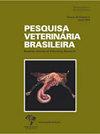难治性猫孢子虫病:临床、组织病理学和细胞病理学方面的比较分析
IF 0.8
4区 农林科学
Q3 VETERINARY SCIENCES
引用次数: 2
摘要
摘要:孢子菌病是由孢子菌引起的慢性真菌感染。长期治疗耐药的病例的发生,特别是猫的鼻平面,强调了研究其发病机制的重要性。本研究的目的是通过细胞病理学和组织病理学检查,分析和比较猫难治性孢子虫病皮肤病变的炎症过程和临床方面。此外,该研究包括13只皮肤有损伤的猫,这些猫对伊曲康唑治疗已有一年多的抗药性。收集皮肤病变样本进行细胞病理学、组织病理学和真菌培养分析。组织片段经苏木精-伊红(HE)和Grocott甲基胺银(GMS)染色。此外,两种临床表现的发生率最高:一般情况良好且病情稳定的动物的局部皮肤形式(n=9, 69.2%)和一般情况较差的猫的弥散性皮肤形式(n=4, 30.8%)。在难治性孢子虫病的猫中,鼻平面(84.6%)是最常见的病变部位。在细胞病理学研究中,少于2个病变且总体状况良好的猫(n= 9,69.2%)表现为没有或轻度酵母强度(每个野区多达5个酵母),巨噬细胞和中性粒细胞强度较低,上皮样细胞、淋巴细胞、浆细胞和嗜酸性粒细胞强度较高。另一方面,(n= 4,30.8%)弥散性孢子菌病和一般情况较差的猫有明显的酵母强度,这些酵母主要被巨噬细胞和中性粒细胞数量增加所吞噬。在一般情况良好的动物中,大多数(n=6, 66.7%)的嗜酸性粒细胞强度较高。在组织病理学上,猫孢子虫病病变以畸形化脓性肉芽肿为主(n=9, 69.2%),其次为形态良好的肉芽肿(n=4, 30.8%)。畸形肉芽肿表现为轻度至中度真菌强度(55.6%),在一般情况良好和局部病变的动物中,真菌强度明显(44.4%),在疾病弥散形式和一般情况较差的猫中。形态良好的肉芽肿(n=4, 30.7%)具有轻度至中度的真菌负荷强度,75%患有这种类型肉芽肿的动物只有一个病变,总体状况良好。对这些难治性孢子虫病猫进行长期伊曲康唑治疗可使感染得到控制,局部病灶稳定;然而,真菌再激活可能发生,导致旺盛和低效的免疫反应。本文章由计算机程序翻译,如有差异,请以英文原文为准。
Refractory feline sporotrichosis: a comparative analysis on the clinical, histopathological, and cytopathological aspects
ABSTRACT: Sporotrichosis is a chronic fungal infection caused by Sporothrix species. The occurrence of cases that are resistant to long-term treatment, especially in the nasal planum of cats, emphasizes the importance of studying its pathogenesis. The purpose of this study was to analyze and compare the inflammatory process of cutaneous lesions of feline refractory sporotrichosis to clinical aspects through cytopathological and histopathological examination. Moreover, the study included 13 cats with cutaneous lesions that had been resistant to itraconazole treatment for more than a year. Cutaneous lesions samples were collected for cytopathological, histopathological, and fungal culture analyses. Tissue fragments were processed and stained with hematoxylin-eosin (HE) and Grocott methenamine silver (GMS). Further, two clinical presentations had the highest occurrence: the localized cutaneous form in animals with good general condition and stable disease (n=9, 69.2%) and the disseminated cutaneous form in cats with poor general condition (n=4, 30.8%). In cats with refractory sporotrichosis, the nasal planum (84.6%) was the most common location of lesions. In the cytopathological study, cats with fewer than two lesions and in good general condition (n=9, 69.2%) showed absence or mild yeast intensity (up to 5 yeasts per field), lower intensity of macrophages and neutrophils, and higher intensity of epithelioid cells, lymphocytes, plasma cells, and eosinophils. On the other hand, (n=4, 30.8%) of the cats with disseminated sporotrichosis and a poor general condition had a marked intensity of yeasts, which were mostly phagocytosed by an increased number of macrophages and neutrophils. Of those animals with good general condition, the majority (n=6, 66.7%) had higher eosinophil intensity. In histopathology, malformed suppurative granuloma was the predominant type (n=9, 69.2%) in feline sporotrichosis lesions, followed by well-formed granulomas (n=4, 30.8%). Malformed granulomas showed mild to moderate fungal intensity (55.6%) in animals with good general condition and localized lesions while marked fungal intensity (44.4%) in cats with the disseminated form of the disease and poor general condition. Well-formed granulomas (n=4, 30.7%) had mild to moderate intensity of fungal load, and 75% of the animals with this type of granuloma had only one lesion and were in good general condition. Long-term itraconazole treatment in these cats with refractory sporotrichosis can keep the infection under control and localized lesions stable; however, fungus reactivation can occur, resulting in an exuberant and inefficient immune response.
求助全文
通过发布文献求助,成功后即可免费获取论文全文。
去求助
来源期刊

Pesquisa Veterinaria Brasileira
农林科学-兽医学
CiteScore
1.30
自引率
16.70%
发文量
41
审稿时长
9-18 weeks
期刊介绍:
Pesquisa Veterinária Brasileira - Brazilian Journal of Veterinary Research (http://www.pvb.com.br), edited by the Brazilian College of Animal Pathology in partnership with the Brazilian Agricultural Research Organization (Embrapa) and in collaboration with other veterinary scientific associations, publishes original papers on animal diseases and related subjects. Critical review articles should be written in support of original investigation. The editors assume that papers submitted are not being considered for publication in other journals and do not contain material which has already been published. Submitted papers are peer reviewed.
The abbreviated title of Pesquisa Veterinária Brasileira is Pesqui. Vet. Bras.
 求助内容:
求助内容: 应助结果提醒方式:
应助结果提醒方式:


